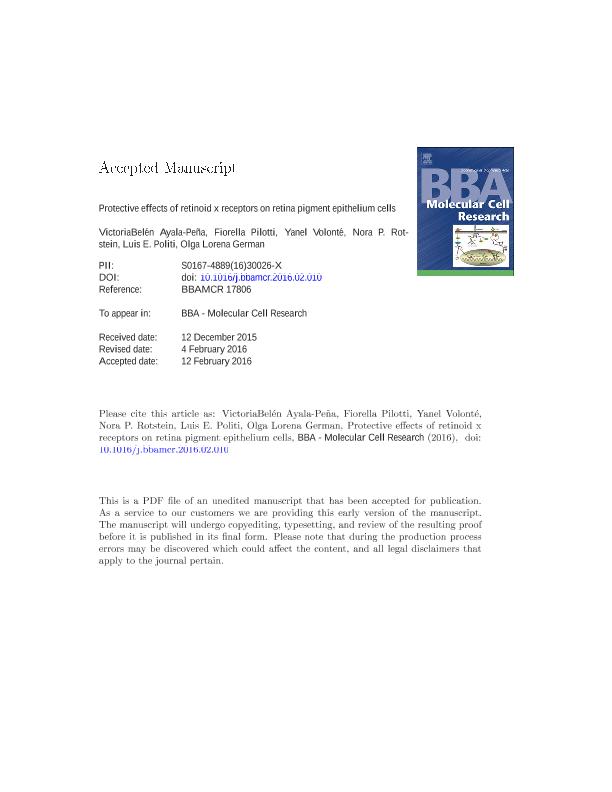Mostrar el registro sencillo del ítem
dc.contributor.author
Ayala Peña, Victoria Belen

dc.contributor.author
Pilotti, Maria Fiorella

dc.contributor.author
Volonté, Yanel Andrea

dc.contributor.author
Rotstein, Nora Patricia

dc.contributor.author
Politi, Luis Enrique

dc.contributor.author
German, Olga Lorena

dc.date.available
2018-03-13T20:30:52Z
dc.date.issued
2016-06
dc.identifier.citation
Ayala Peña, Victoria Belen; Pilotti, Maria Fiorella; Volonté, Yanel Andrea; Rotstein, Nora Patricia; Politi, Luis Enrique; et al.; Protective effects of retinoid x receptors on retina pigment epithelium cells; Elsevier Science; Biochimica et Biophysica Acta-Molecular Cell Research; 1863; 6; 6-2016; 1134-1145
dc.identifier.issn
0167-4889
dc.identifier.uri
http://hdl.handle.net/11336/38700
dc.description.abstract
Age-related macular degeneration (AMD) is among the main pathologies leading to blindness in adults and has currently no cure or effective treatment. Selective apoptosis of retina pigment epithelial (RPE) cells results in the progressive loss of photoreceptor neurons, with the consequent gradual vision loss. Oxidative stress plays an important role in this process. We have previously determined that activation of RXRs protects rat photoreceptor neurons from oxidative stress-induced apoptosis. In this study we investigated whether RXR ligands prevented apoptosis in an RPE cell line, D407 cells, exposed to hydrogen peroxide (H2O2). H2O2 induced apoptosis of D407 cells, promoting p65NFκB nuclear translocation, increasing Bax mRNA expression, activating caspase-3 and altering cell morphology. We show, for the first time, that HX630, a RXR pan-agonist, protected D407 cells from H2O2-induced apoptosis, preventing p65NFκB nuclear translocation, increasing Bclxl and PPARγ mRNA levels and simultaneously decreasing Bax mRNA levels and caspase-3 activation. Pretreatment with a RXR antagonist blocked HX630 protection. LG100754, which binds RXRs but only activates heterodimers and is an antagonist of RXR homodimers, also had a protective effect. In addition, only agonists known to bind to RXR/PPARγ were protective. As a whole, our results suggest that RXR activation protects RPE cells from oxidative stress-induced apoptosis and this protection might involve signaling through a heterodimeric receptor, such as RXR/PPARγ. These data also imply that RXR agonists might provide potential pharmacological tools for treating retina degenerative diseases.
dc.format
application/pdf
dc.language.iso
eng
dc.publisher
Elsevier Science

dc.rights
info:eu-repo/semantics/openAccess
dc.rights.uri
https://creativecommons.org/licenses/by-nc-nd/2.5/ar/
dc.subject
Hydrogen Peroxide
dc.subject
Oxidative Stress
dc.subject
Peroxisome Proliferator-Activated Receptor
dc.subject
Retina Pigment Epithelium Cells
dc.subject
Retinoid X Receptors
dc.subject.classification
Otras Ciencias Biológicas

dc.subject.classification
Ciencias Biológicas

dc.subject.classification
CIENCIAS NATURALES Y EXACTAS

dc.title
Protective effects of retinoid x receptors on retina pigment epithelium cells
dc.type
info:eu-repo/semantics/article
dc.type
info:ar-repo/semantics/artículo
dc.type
info:eu-repo/semantics/publishedVersion
dc.date.updated
2018-03-12T19:22:31Z
dc.journal.volume
1863
dc.journal.number
6
dc.journal.pagination
1134-1145
dc.journal.pais
Países Bajos

dc.journal.ciudad
Amsterdam
dc.description.fil
Fil: Ayala Peña, Victoria Belen. Consejo Nacional de Investigaciones Científicas y Técnicas. Centro Científico Tecnológico Conicet - Bahía Blanca. Instituto de Investigaciones Bioquímicas de Bahía Blanca. Universidad Nacional del Sur. Instituto de Investigaciones Bioquímicas de Bahía Blanca; Argentina
dc.description.fil
Fil: Pilotti, Maria Fiorella. Consejo Nacional de Investigaciones Científicas y Técnicas. Centro Científico Tecnológico Conicet - Bahía Blanca. Instituto de Investigaciones Bioquímicas de Bahía Blanca. Universidad Nacional del Sur. Instituto de Investigaciones Bioquímicas de Bahía Blanca; Argentina
dc.description.fil
Fil: Volonté, Yanel Andrea. Consejo Nacional de Investigaciones Científicas y Técnicas. Centro Científico Tecnológico Conicet - Bahía Blanca. Instituto de Investigaciones Bioquímicas de Bahía Blanca. Universidad Nacional del Sur. Instituto de Investigaciones Bioquímicas de Bahía Blanca; Argentina
dc.description.fil
Fil: Rotstein, Nora Patricia. Consejo Nacional de Investigaciones Científicas y Técnicas. Centro Científico Tecnológico Conicet - Bahía Blanca. Instituto de Investigaciones Bioquímicas de Bahía Blanca. Universidad Nacional del Sur. Instituto de Investigaciones Bioquímicas de Bahía Blanca; Argentina
dc.description.fil
Fil: Politi, Luis Enrique. Consejo Nacional de Investigaciones Científicas y Técnicas. Centro Científico Tecnológico Conicet - Bahía Blanca. Instituto de Investigaciones Bioquímicas de Bahía Blanca. Universidad Nacional del Sur. Instituto de Investigaciones Bioquímicas de Bahía Blanca; Argentina
dc.description.fil
Fil: German, Olga Lorena. Consejo Nacional de Investigaciones Científicas y Técnicas. Centro Científico Tecnológico Conicet - Bahía Blanca. Instituto de Investigaciones Bioquímicas de Bahía Blanca. Universidad Nacional del Sur. Instituto de Investigaciones Bioquímicas de Bahía Blanca; Argentina
dc.journal.title
Biochimica et Biophysica Acta-Molecular Cell Research

dc.relation.alternativeid
info:eu-repo/semantics/altIdentifier/url/http://www.sciencedirect.com/science/article/pii/S016748891630026X
dc.relation.alternativeid
info:eu-repo/semantics/altIdentifier/doi/http://dx.doi.org/10.1016/j.bbamcr.2016.02.010
Archivos asociados
